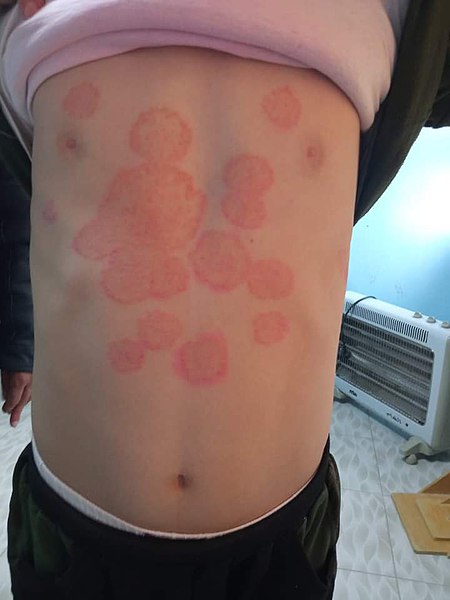Playlist
Show Playlist
Hide Playlist
Tinea Capitis and Tinea Barbae Infections on Darker Skin
-
Slides Tinea Capitis and Tinea Barbae Infections on Darker Skin.pdf
-
Download Lecture Overview
00:02 Welcome to our lecture on Dermatophyte infections involving the hair. 00:07 In this lecture we're going to cover tinea capitis and tinea barbae as two major clinical manifestations of dermatophyte hair infections. 00:16 Tinea capitis is a dermatophyte infection of the scalp involving both skin and hair. 00:23 It is caused by Trichophyton tonsurans, Microsporum canis, as well as Microsporum gypseum. 00:33 It usually affects pre-adolescent children between the ages of three and seven years, and of course, immunocompromised adults from whatever cause. 00:43 Tinea capitis can present as non-inflammatory or inflammatory variant. 00:49 The Non-inflammatory variant.], let's have a look at that, presents as a gray patch where one is fine scaling of the scalp and patches of alopecia, which appear gray due to spores containing the affected hairs. 01:03 The black dot. This presents with fine scaling, with patches of alopecia speckled with black dots, and the black dots are equivalent to broken hair shafts. 01:16 The third type of noninflammatory is the widespread scaling with subtle hair loss. 01:25 Now let's take a look at the inflammatory variants of fungal infection that involves the hair. We have the diffuse pustular pattern where one sees patchy alopecia with pustules or folliculitis. 01:40 The second variant is the keri on, which presents as inflammatory plaque with pustules. This is a result of intense immune response to the infection. 01:52 The third type is favus. 01:56 This clinical presentation is unique to the infection of Trichophyton schoenleinii. 02:03 In all the variants of tinea capitis, one tends to find cervical lymph nodes, which may be palpable. 02:13 The differential diagnosis for tinea capitis, irrespective of the variant, commonly is psoriasis, alopecia areata. And alopecia areata, you tend to find a smooth area of hair loss. 02:27 There's no scaling. Whereas in tinea capitis, the hair loss is associated with scaling. 02:33 And alopecia areata is usually asymptomatic. 02:35 It's not itchy. Seborrheic dermatitis is another differential. 02:40 And here there's inflammation and crusting. 02:45 Now let's have a look at tinea barbae. 02:49 It's a dermatophyte infection of the beard and mustache areas. 02:53 It's usually caused by zoophilic fungi. 02:56 As mentioned before, these are fungi that are transmitted from animals to the humans. 03:03 And the following are the common causes of tinea barbae. 03:09 The clinical manifestations involve red, lumpy areas, pustules and crusting around the hairs over the beard. 03:19 Hairs can be easily pulled out in these patients with tinea barbae. 03:27 The differential diagnosis includes bacterial folliculitis and pseudofolliculitis barbae. 03:34 So how do we diagnose dermatophyte infections of the hair? Physical examination looking for clinical clues. 03:43 Dermoscopy. That is, trichoscopy has typical features. 03:47 For example, in tinea capitis, one sees corkscrew hairs and broken hairs. 03:54 One can also pull the hair root for sample and send it for microscopy and culture. 04:00 Wood's lamp is also used, and this can distinguish between fluorescent and non-fluorescent dermatophytes that affect the hair. 04:13 In terms of treatment, topical antifungal shampoos are useful for prevention of spread of infection, but on their own they are not adequate to treat tinea capitis or tinea or sycosis barbae. 04:27 So we use oral antifungals and the list is there. 04:32 Griseofulvin, itraconazole, fluconazole, terbinafine and the dosages may vary in children. Secondary bacterial infections should be treated with oral antibiotics, as this may occur in some patients with tinea capitis or sycosis barbae.
About the Lecture
The lecture Tinea Capitis and Tinea Barbae Infections on Darker Skin by Ncoza Dlova is from the course Fungal Skin Infections in Patients with Darker Skin.
Included Quiz Questions
Which clinical presentation of tinea capitis is characterized by fine scaling with patches of alopecia speckled with black dots representing broken hair shafts?
- Black dot variant
- Gray patch variant
- Kerion variant
- Favus variant
- Diffuse pustular variant
Which diagnostic tool is specifically used to distinguish between fluorescent and non-fluorescent dermatophytes that affect the hair?
- Wood's lamp
- Dermoscopy
- Potassium hydroxide preparation
- Fungal culture
- Polymerase chain reaction
Customer reviews
5,0 of 5 stars
| 5 Stars |
|
5 |
| 4 Stars |
|
0 |
| 3 Stars |
|
0 |
| 2 Stars |
|
0 |
| 1 Star |
|
0 |




